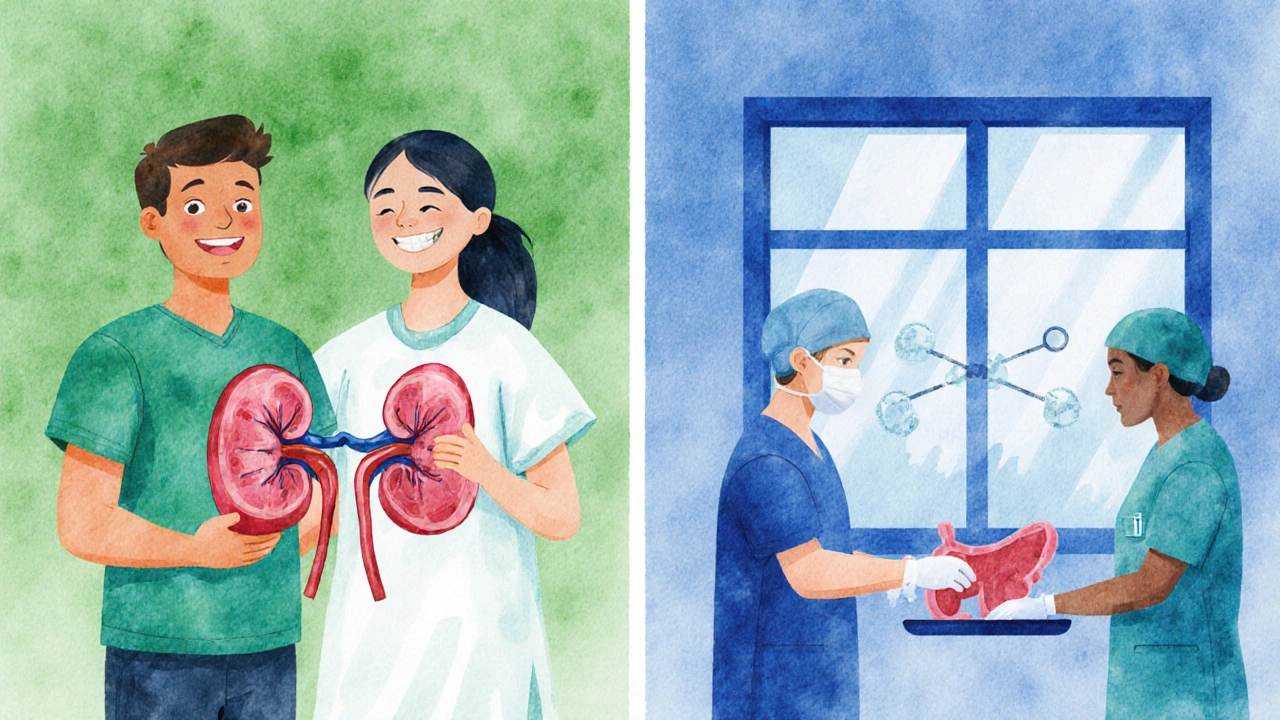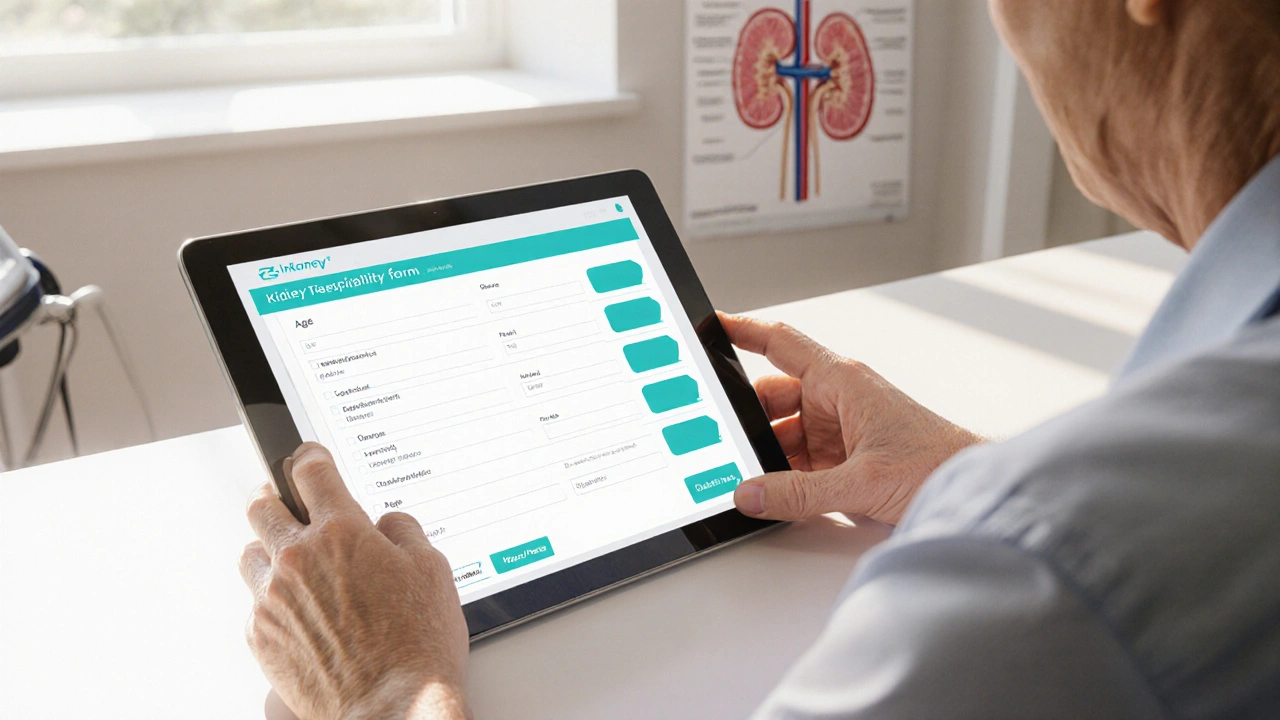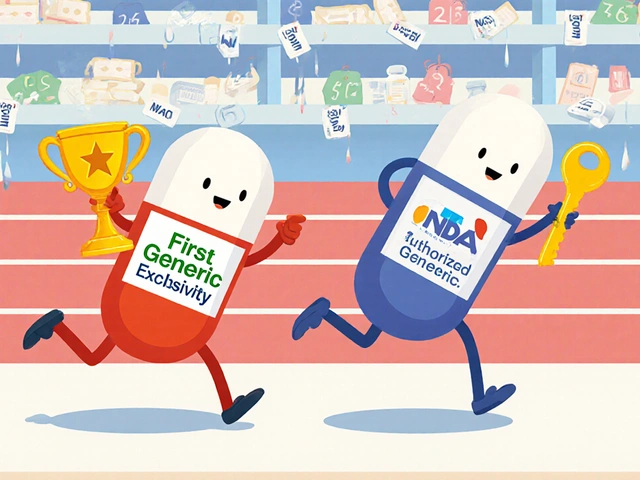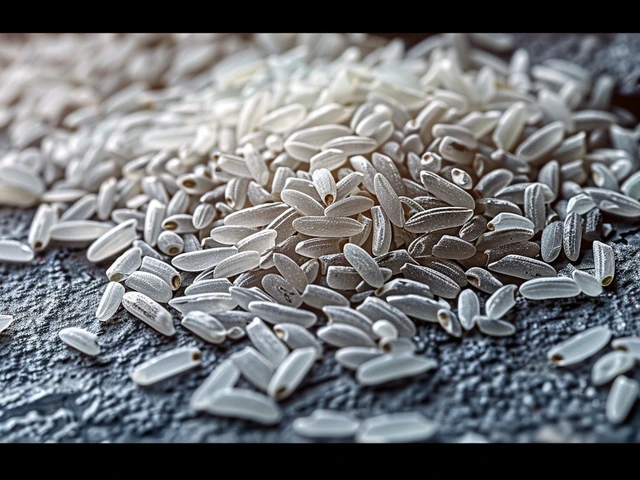Kidney Transplant Decision Helper
Enter your information and click "Evaluate My Eligibility" to see personalized recommendations.
A kidney transplant is a surgical procedure that replaces a failing kidney with a healthy one from a donor. It is a cornerstone treatment for patients with end‑stage renal disease (ESRD) who no longer respond to dialysis or medication.
Quick Takeaways
- Kidney transplants can extend life by 10‑15 years on average compared with dialysis.
- Living‑donor transplants usually offer better graft survival than deceased‑donor transplants.
- Immunosuppressive therapy is essential but raises infection risk.
- Pre‑surgical evaluation includes blood type matching, tissue typing, and cardiovascular screening.
- Post‑op care focuses on medication adherence, infection monitoring, and lifestyle adjustments.
Understanding the Core Entities
When we talk about kidney transplantation, several related concepts matter:
- End‑stage renal disease (ESRD) - the final stage of chronic kidney disease where kidneys function at less than 10% of normal.
- Living donor - a healthy individual (often a relative) who donates one kidney.
- Deceased donor - a donor who has passed away and whose organs are allocated by national registries.
- Immunosuppressive therapy - drugs that prevent the recipient’s immune system from rejecting the new organ.
- Dialysis - the alternative treatment that filters blood when kidneys fail.
- Graft survival - the length of time the transplanted kidney continues to function.
- Transplant rejection - the immune response that can damage the new kidney.
- Transplant center - a specialized hospital unit that handles evaluation, surgery, and after‑care.
Who Needs a Kidney Transplant?
Patients typically move to transplantation after spending months or years on dialysis and meeting these criteria:
- Glomerular filtration rate (GFR) below 15mL/min/1.73m².
- Persistent symptoms such as fatigue, anemia, or fluid overload despite optimal medical therapy.
- Absence of severe comorbidities that would make surgery unsafe (e.g., uncontrolled heart disease).
In Australia, the Australian and New Zealand Dialysis and Transplant Registry reported that in 2023, 5,800 people started dialysis, but only 2,100 received a transplant, underscoring the supply‑demand gap.
Risks Involved
Every surgery has inherent risks, and kidney transplants are no exception. The most common complications include:
- Infection: Immunosuppressants lower immunity, making bacterial and viral infections more likely.
- Acute rejection: Occurs in about 10‑15% of recipients within the first three months.
- Delayed graft function: The new kidney may not work immediately, requiring temporary dialysis.
- Cardiovascular events: Surgery stress can trigger heart attacks or strokes, especially in older patients.
- Side effects of medication: Steroids can cause weight gain, high blood pressure, and mood swings.
Long‑term, the risk of chronic rejection rises after five years, leading to a gradual decline in kidney function.
Benefits That Make It Worthwhile
Despite the risks, the upside is compelling:
- Median survival post‑transplant is 12‑15 years for deceased donors and up to 20 years for living donors, compared with 5‑7 years on dialysis.
- Quality‑of‑life scores (measured by the KDQOL‑36 questionnaire) improve by roughly 30% within six months.
- Transplant recipients often experience fewer dietary restrictions and can travel more freely.
- Healthcare costs drop after the first year; a 2022 Australian health‑economics study showed a $45,000 reduction in annual expenses per patient.

Living Donor vs. Deceased Donor: A Direct Comparison
| Metric | Living Donor | Deceased Donor |
|---|---|---|
| 1‑year graft survival | 98% | 93% |
| 5‑year graft survival | 85% | 70% |
| Average waiting time | Weeks to months (if donor ready) | 3‑5years (Australia average) |
| Post‑op complication rate | 10‑12% | 15‑20% |
| Recipient quality‑of‑life improvement | High (often return to work within 6months) | Moderate (more post‑surgical recovery) |
What to Expect Before Surgery
The journey starts months ahead of the operation:
- Evaluation: Blood typing, HLA tissue typing, and cardiac clearance. The transplant center also reviews psychosocial factors.
- Donor matching: For living donors, surgeons perform imaging (CT angiography) to assess kidney anatomy.
- Education: Recipients attend workshops on medication adherence and infection prevention.
- Pre‑operative labs: CBC, liver panel, and viral screening (CMV, EBV, hepatitis).
During this phase, most patients stay on dialysis until the surgery date, unless a living donor is ready.
Day of Surgery and Hospital Stay
The operation typically lasts 3-4hours. Surgeons connect the donor kidney to the recipient’s blood vessels and urinary system. After the anastomosis, they monitor urine output-usually the first sign the graft is working.
Hospitalization averages 5‑7days. Early mobility, pain control, and careful fluid balance are critical. Patients start immunosuppressive drugs (tacrolimus, mycophenolate, low‑dose steroids) within hours of the transplant.
Life After the Transplant
Post‑op life revolves around three pillars:
- Medication adherence: Skipping a dose can trigger rejection. Blood level checks for tacrolimus are done weekly at first.
- Infection vigilance: Flu shots, pneumococcal vaccines, and regular skin checks are standard.
- Lifestyle tweaks: Low‑sodium diet, regular exercise, and avoidance of high‑impact sports that could damage the graft.
Routine follow‑up visits occur at 1, 3, 6, and 12months, then annually. Lab work includes serum creatinine, eGFR, and urine protein tests.
Common Concerns Addressed
Will I need dialysis again? Only if the graft fails. About 10‑15% experience chronic rejection within the first decade, at which point a second transplant or dialysis may be necessary.
Can I travel? Yes, after the 3‑month healing window. Keep immunosuppressants on hand, stay hydrated, and avoid extreme heat.
What about pregnancy? Women can conceive once kidney function stabilizes (usually after 1‑2years) and under close obstetric‑nephrology care.
Decision‑Making Checklist
- Do you have a compatible living donor? If yes, prioritize that option.
- Are you medically cleared for surgery? Cardiovascular health is a key factor.
- Can you commit to lifelong medication and monitoring?
- Do you understand the financial implications (insurance coverage, out‑of‑pocket costs)?
- Have you discussed fertility or career plans with your transplant team?
Answering these questions honestly helps you and your doctors choose the best path forward.

Frequently Asked Questions
How long does a kidney transplant surgery take?
The procedure usually lasts between three and four hours, plus additional time for anesthesia induction and post‑operative monitoring.
What are the most common side effects of immunosuppressive drugs?
Patients often experience weight gain, high blood pressure, increased blood sugar, and mood changes. Regular labs help adjust dosages to minimize these effects.
Can a diabetic patient receive a kidney transplant?
Yes. Diabetes is a common cause of ESRD, and transplant programs routinely evaluate diabetic patients. Tight glucose control before and after surgery improves outcomes.
How is a donor kidney matched to a recipient?
Matching involves blood type compatibility, HLA tissue typing, and size considerations. The better the match, the lower the rejection risk.
What is the typical recovery timeline after a kidney transplant?
Most patients leave the hospital within a week, resume light activities within two weeks, and return to normal work or school by three to six months, depending on individual health.







Comments(12)